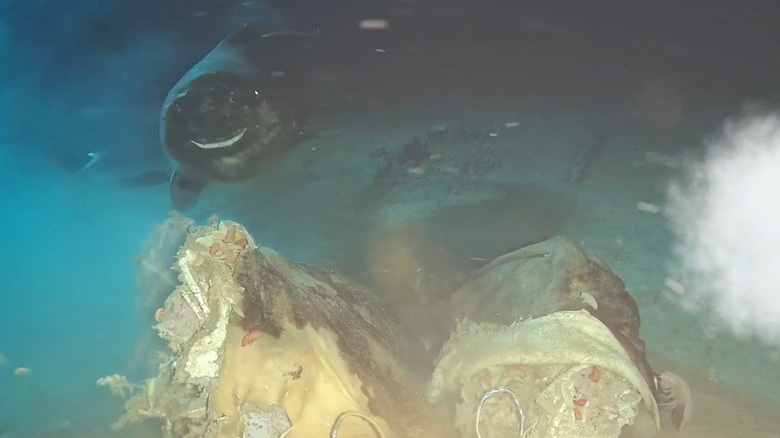Scientists Dropped A Cow Carcass Into The South China Sea And Made A Fascinating Discovery
Researchers have been investigating Earth's oceans for centuries, and as submersible technology improves, they make new and interesting discoveries. However, some animals that live in the bathyal zone, an area of the ocean between 3,000 and 13,000 feet under the surface, have eluded observation — in particular the Pacific sleeper shark. This enormous species has been documented in other areas but never in the South China Sea until scientists sank a cow carcass to about 5,344 feet underwater and caught it on camera.
The purpose of sinking a cow carcass on the continental slope on the southeast side of Hainan Island, which is located on the northern end of the South China Sea, was to investigate how large deep-sea animals feed. What wasn't expected was eight Pacific sleeper sharks to emerge. Reported in Ocean-Land-Atmosphere Research, it's the first time this species has been observed this far south.
While Pacific sleeper sharks have been spotted as far south as Baja California, they've mostly been observed in the northern part of the Pacific Ocean, from the waters around Japan to the Bering Sea and Gulf of Alaska. Because of that, they're associated more with colder, deeper habitats than the warmer, tropical waters around Hainan. Their discovery here suggests that their range is larger than had been previously guessed.
Intriguing feeding behaviors of the Pacific sleeper shark
In video footage released on YouTube, you can see the interesting queuing behaviors of the sharks, which typically live in the pelagic zone (essentially the entirety of the non-coastal ocean). While the bigger sharks — which measured longer than 9 feet — aggressively tore into the carcass, the smaller ones cautiously circled the feeding area. The intriguing part is that the feeding sharks would yield their spots to those approaching from behind, giving them priority.
Pacific sleeper sharks may not be among the strangest deep sea creatures ever discovered — we nominate the goblin shark for that distinction — but this feeding behavior resembles that of sharks scavenging from large animal carcasses near the surface. Study author Han Tian said in a statement, "This behavior suggests that feeding priority is determined by individual competitive intensity, even in deep-water environments, reflecting a survival strategy suitable for non-solitary foraging among Pacific sleeper sharks."
Additionally, the sharks exhibited unmistakable eye retraction while feeding. Scientists think this is an adaptation the sharks use as a defensive mechanism. That's because this species doesn't have a nictitating membrane — a thin membrane that extends across the eye, protecting it — and debris from the ocean floor was kicked up around them as they fed. On top of that, all eight of the sharks observed were female, suggesting that the South China Sea could be a nursery, especially since other large, deep-sea species display a female bias in this region.

